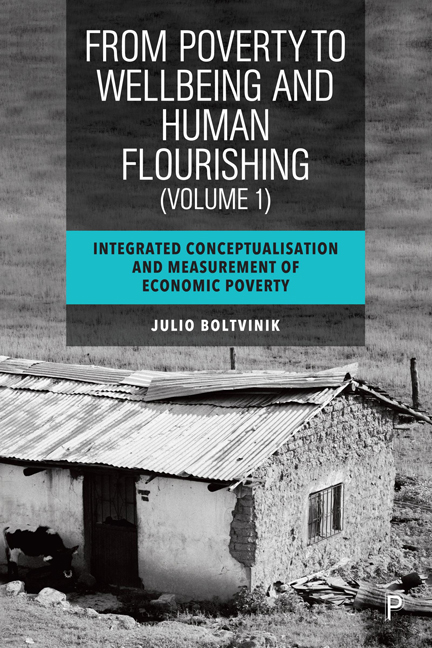 From Poverty to Well-Being and Human Flourishing
From Poverty to Well-Being and Human Flourishing Published online by Cambridge University Press: 28 March 2024
6.1 A systematic typology: comparison with Gordon et al.’s and Ringen’s views of poverty measurement methods
The typology I present here classifies PMM, in the first place, into normative (No), semi-normative (SN) or non-normative (NN) methods. I consider normative those PMM that define the threshold(s) separating the poor from the non-poor based on a notion of the acceptable minimum level of life or on a conception of the N that must be satisfied, and the S required to meet them. No and SN methods are additionally classified on the basis of two characteristics: the direct or indirect nature of the measurement of WB (or deprivation) and the use of one or various indicators in one or various dimensions. This gives rise to the further classification of methods into the categories of direct and indirect, and one-dimensional and multidimensional. The methods that use both direct and indirect indicators I call combined.
In the following pages I compare this typology with Ringen’s (1995), as well as with the methods described by Gordon et al. (2000). I include a critique of direct and indirect methods, leaving the critique of combined methods for Chapter 7.
I have not included Sen’s CA in the typology, since it has not been made operational to measure P or the standard of living. Neither have I included the measurement of social exclusion, for this concept is different from that of P, regardless of the serious difficulties encountered for its definition and measurement.
Table 6.1 presents a synthetic typology of PPM. The typology is built on three axes: the first axis (displayed in the columns) is the one-dimensional or multidimensional character of each method; the second (displayed in the rows), the indirect, direct or combined nature of each method; and the third (also shown in the rows), the No, SN or NN character of the methods (the first two categories have been grouped together in the table). All the NN methods included are indirect. With these simplifications, a matrix with potentially 18 cells was reduced to an eight-cell matrix where three cells remain empty.
To save this book to your Kindle, first ensure no-reply@cambridge.org is added to your Approved Personal Document E-mail List under your Personal Document Settings on the Manage Your Content and Devices page of your Amazon account. Then enter the ‘name’ part of your Kindle email address below. Find out more about saving to your Kindle.
Note you can select to save to either the @free.kindle.com or @kindle.com variations. ‘@free.kindle.com’ emails are free but can only be saved to your device when it is connected to wi-fi. ‘@kindle.com’ emails can be delivered even when you are not connected to wi-fi, but note that service fees apply.
Find out more about the Kindle Personal Document Service.
To save content items to your account, please confirm that you agree to abide by our usage policies. If this is the first time you use this feature, you will be asked to authorise Cambridge Core to connect with your account. Find out more about saving content to Dropbox.
To save content items to your account, please confirm that you agree to abide by our usage policies. If this is the first time you use this feature, you will be asked to authorise Cambridge Core to connect with your account. Find out more about saving content to Google Drive.